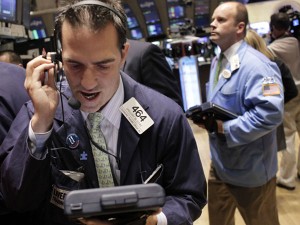
In this July 25, 2011 photo, trader Gregory M. Rowe (left) works on the floor at the New York Stock Exchange in New York. The deadlock over raising the U.S. debt ceiling continued to weigh on stocks and the dollar Tuesday, July 26, after President Barack Obama warned that his country was dangerously close to a default. AP Photo/Seth Wenig
NEW YORK — The U.S. averted a debt default Tuesday when President Barack Obama signed a bill raising the country’s debt ceiling into law. But that might not enough to maintain its coveted AAA debt rating, according to Fitch Ratings.
U.S. debt has held a AAA rating since 1917. Currently, fewer than 20 countries have AAA ratings. Among them: the United Kingdom, Australia, Germany and Singapore.
On Tuesday, Fitch said the agreement to raise the debt ceiling and make spending cuts was an important first step but “not the end of the process.” The rating agency said it wants to see a credible plan to reduce the budget deficit “to a level that would secure the United States’ ‘AAA’ status.”
Fitch expects to conclude its review of the U.S.’s debt rating by the end of August. Given the terms of the debt deal signed Tuesday, it is possible the U.S. debt rating could be downgraded at that time, Fitch said.
David Riley, managing director at Fitch, said in an interview with The Associated Press: “There’s more to be done in order to keep the rating in the medium-term.”
Fitch is one of the three main ratings agencies that rate debt that is issued by countries, states, corporations and municipalities. Ratings are based on a likelihood of default. The AAA rating is the highest available and signifies an extremely low likelihood of default.
The two agencies — Moody’s Investors Service and Standard & Poor’s — declined to comment Tuesday. In recent weeks, both have signaled that they might downgrade the country’s debt rating to AA. S&P said in mid-July that there was a 50-50 chance it would downgrade U.S. debt. Had the country defaulted, experts have said a downgrade by all three agencies would have been likely.
The U.S. has only faced the threat of a downgrade once in the last 96 years. In 1995, when Bill Clinton was president, a similar default loomed and the credit rating agencies threatened a downgrade. But once Congress resolved that debt crisis, the credit agencies removed the threat.
Now, many analysts believe the U.S. will be downgraded. And, they said it will be a tougher to regain the AAA rating.
Federated Investors’ chief fixed income strategist Joe Balestrino points out that during the Clinton era the U.S. economy was growing at a much faster pace. Now, the economy is emerging from the deepest recession since the Great Depression and growth is sluggish. On Friday, the government said that in the first half of the year, the economy grew at its slowest pace since the recession officially ended in June 2009.
“Growth healed all wounds in 1995,” said Balestrino. “However, now the U.S. doesn’t have enough vitality to grow its way out.”
Recent weak economic reports echo that point. Riley, the Fitch managing director, said he was worried about the weak economic news of the last few days. On Tuesday, the Commerce Department said that consumers cut their spending in June for the first time in nearly two years. On Monday, another report showed weakness in manufacturing.
“If the economy won’t grow at 2.5 percent over the long term, it has pretty profound implications from a fiscal point of view,” said Riley.
He said “that means the U.S. is poorer than it thought” and that legislators will face even tougher choices “in terms of taxes and spending,” he said.
The ratings agency also said that between federal, state and local government debt U.S. government debt will be as large as the country’s economy by the end of 2012 — or 100 percent of the country’s gross domestic product. And Fitch said it expects the country’s debt level will continue to rise. The agency warned that would not consistent with a debt level that would allow the U.S. to retain its AAA sovereign rating.
In the short term, Balestrino and others don’t expect investors to start selling their Treasury holdings. That’s because Treasurys are considered one of the safest investment options.
Fitch said the status of the U.S. dollar and the size of the Treasury market are the biggest reasons investors won’t abandon Treasurys soon. The dollar is the global reserve currency, which means a significant amount of global trade is made in dollars — from toys and computer chips from China, coffee from Kenya or cars from Japan. Central banks in other countries therefore hold large reserves of U.S. currency, mostly through Treasury purchases.
The U.S. Treasury market is the largest government bond market, at $9.3 trillion.